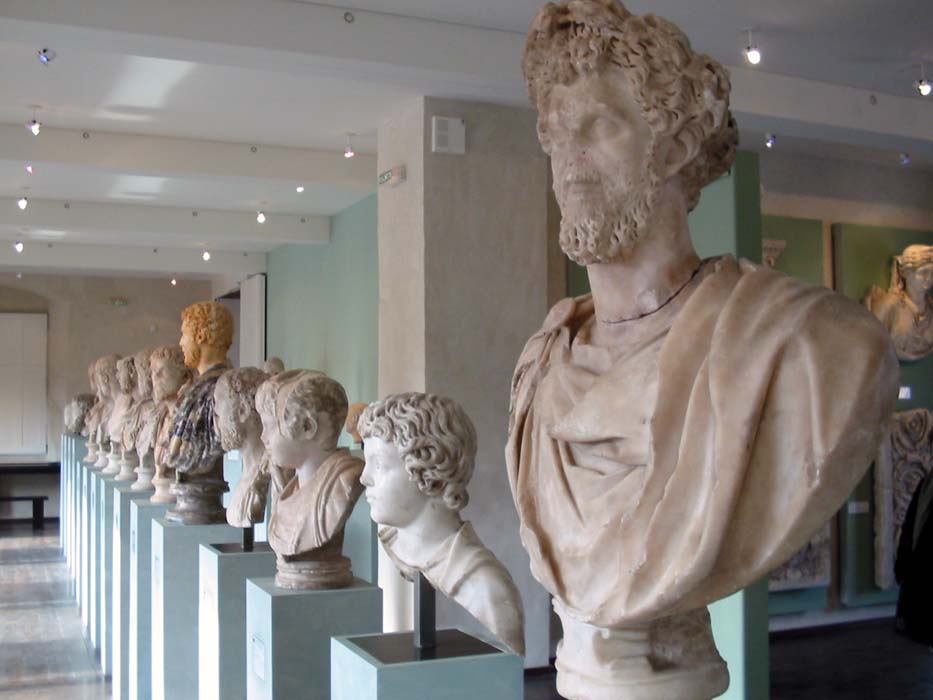
This very short article will compare some statues of Roman Emperors with similar portraits on ancient coins: to do so, I'll use some photos I took in Toulouse (France) and some coins selected from Forum catalogue.
The Musée Saint-Raymond (Musée des Antiques or Museum of Ancient Artifacts) of Toulouse (France) is known in particular for its exceptional collection of sculptured Roman portraits.
The most impressive part of this collection – a long gallery of heads and busts of Roman Emperors (and their wives or other important persons, in some cases) – comes from the ruins of the Roman villa of Chiragan near Martres-Tolosane. This is not a new discovery: the luxurious villa, adorned with marble of all sorts, had been discovered in 1826 and the first publication has been done in 1901 by the archaeologist Léon Joulin. But the exposition has recently been completely renewed and new pieces are now exhibited.

In other parts of the same Museum you can also admire some other statues, which are coming from different places, in particular from the forum of Béziers (discovery of April 1844), another village near Toulouse.
In general, these items are all coming from the southern provinces of Gaul, but have been probably realised in Rome itself to be sent there as an instrument of propaganda to spread the image of the Emperor, and – maybe – even to inspire the celators of the mint of Lugdunum, because coins were an active part of the “communication system” spreading the image of the Emperor through the Empire…
Apart from giving you the previous short introduction about the origin of the images I’m going to show, I don’t want to bore you with too many words: these statues are speaking better than me! But let me give you a couple of other notices concerning these images.
First of all, I have to apologize to serious lovers of ancient sculpture: they like to see statues with real light playing on them in the round and I transformed the images into cameo thumbnails with black background. This is the kind of elaboration performed in the "vilest tourist publications for sale in kiosks" (to use the description of a very serious art lover, honouring us with her comments on the discussion board: Patricia Lawrence): I've done this modification (deturpation?) in order to have an acceptable degree of homogeneity between different images in the layout of this web page, but I understand that this is a meretricious use of art, because I enslaved the original artwork to a prosaic presentation in a web page. Fortunately I can do something to offer a (partial?) remedy: it is possible to see at least the original picture by clicking on the "cameo" and - in several cases - it is even possible to see two or more pictures taken from different angles, so that you can get a feeling of the three-dimensionality and solidity of the sculpture, while I was walking around them with my camera. (Unfortunately, since I'm not a very good photographer and since it is not possible to use tripods and flashed in French museums, some of my shots were so bad that I do not have a decent complete set of images for all the statues.)
Moreover, the obverse/reverse image of the coins will be visible by clicking on them (the images and descriptions are taken from Forum catalogue - as you may see from the catalogue number - even if some of the coins are now in my collection as well). Clearly, coins too would be nicer if seen from several angles in a three-dimensional space, especially the denarii of the first century of the Empire with their high relieves: the nice thing is that you don't need to travel too much to handle one, since these coins - reproducing in such an impressing way the sculptures of the time - are generally quite inexpensive.
To conclude, if you want to get the real feeling of a gallery with the portraits of some of the greatest emperors, you can always go to Toulouse and see this beautiful museum: at the end of the gallery, if you're not astonished enough, you may see a genealogic three of roman emperors created using their aurei (if existing) and denarii... And - in any case - you have quite a lot of other reasons to visit Toulouse, including other museums and works of art and the beautiful pilgrimage church of St-Sernin (which is at a few meters from the Museé Saint-Raymond).